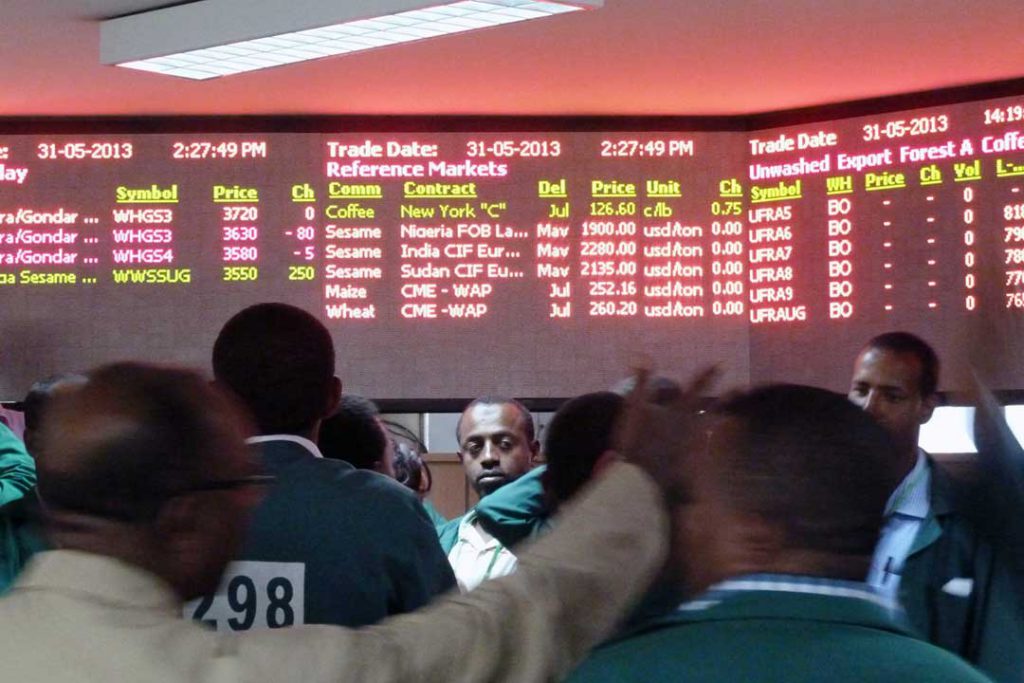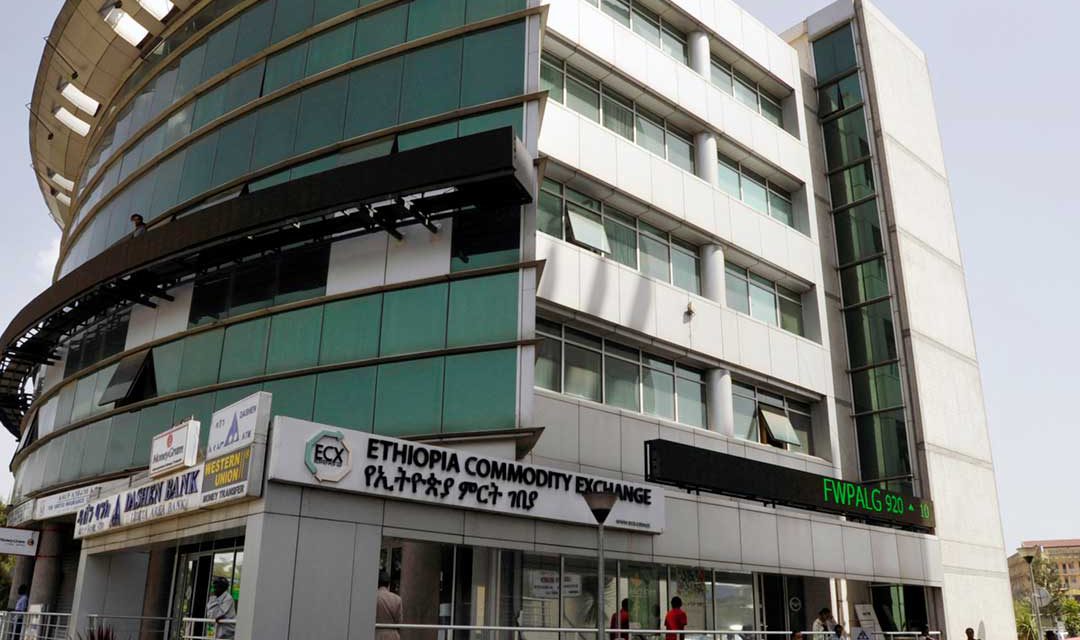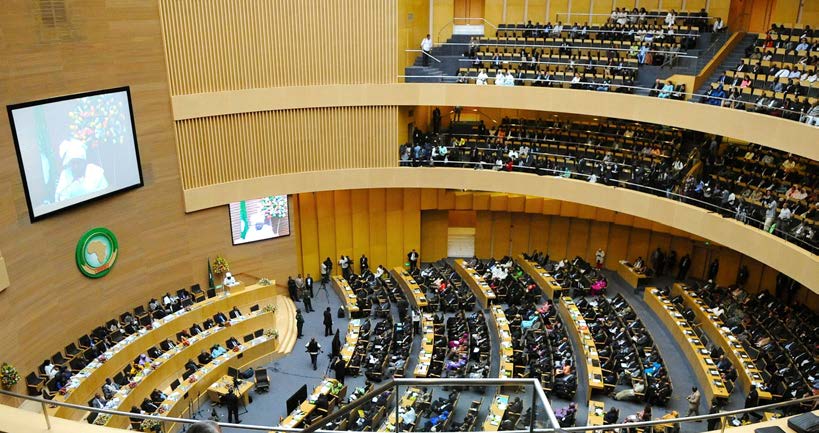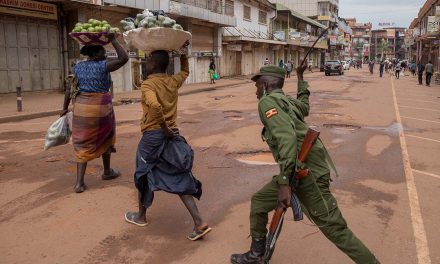How cash-strapped farmers get their goods to market quickly and at a fair, transparent price

In a small, tidy office on the top floor of the Ethiopian Commodity Exchange building in Addis Ababa, communications manager Tewodros Assefa draws two diagrams on a large glass window pane. The window overlooks the capital city’s new light rail line, a raised concrete snake that bisects the city. This scene is unexpectedly sophisticated: a modern, first world pastiche in a country better known, not always fairly, for poverty and chaos. Like the new metro, the Ethiopian Commodity Exchange—better known as ECX—is a physical expression of the Ethiopian government’s massive drive to change this image. The big development push has lifted millions out of poverty. But sacrifice has partnered this success: open political space in Ethiopia is nearly non-existent; and the government holds a poor record on human rights. The ECX, however, is an example of government achievement, as Mr Assefa’s two diagrams illustrate. His first drawing is simple: a stick figure represents a farmer, while a car is a commodities exporter.
An arrow links the two to show the 20km round-trip that a farmer must make to get his goods to market, where the exporter’s car is waiting. This seems a short distance for those who have their own wheels. But it is a very long way for the average Ethiopian farmer, who makes the trip on foot or with a donkey laden with 10kg bags of product. Even worse, by the time the farmer gets to the market, he or she has invested too much time and effort in the journey to return empty-handed. The product must sell, no matter what, which gives the exporter the upper hand in the negotiations. The exporter can name his price, and the farmer — with only one market for the goods — must accept. This exploitative relationship allowed exporters to post margins of 300%-400%, according to Mr Assefa, until the ECX was established in 2008. Then Mr Assefa draws a triangle to illustrate the new process. Exporters, now called ECX clients, occupy the top, followed by ECX members. Agricultural cooperatives and farmers sit at the bottom.
This is how it works: the 3.1m farmers that are signed up to ECX still have to lug their goods to market, but now they deliver to one of 33 agricultural cooperatives. This does not necessarily shorten their journey, but guarantees them a buyer and a fair price, making the journey worthwhile. These cooperatives, representing many farmers, then sell to the 350 ECX members, who store the goods in several ECX warehouses scattered across the country. These members then deal with the exporters. Crucially, all players have access to real-time price information at every stage of the process and know roughly how much they should be clearing. Electronic tickers running in 90 locations throughout Ethiopia and two mobile services provide price updates on demand: using an Ethiopian cellphone, a farmer dials 929 for an interactive voice response or 934 for an SMS service. To prevent fraud and guarantee payment, ECX officials measure and grade the quality of all goods received.
Buyers must lodge a deposit with ECX before they negotiate, guaranteeing that promised funds will be available to members. Payment is delivered at 11am the day after a trade is concluded. On one level it is a counter-intuitive system. Usually, cutting out the middlemen generates efficiency and accountability. In this case, however, it is the addition of the intermediaries — the cooperatives and the ECX members — who ensure that commodity profits are spread more evenly throughout the supply chain and that no one is ripped off, including the taxman, who can easily trace commodity payments. ECX’s role is to underwrite the process, from the quantity and quality of the goods supplied to their delivery and payment. It also hosts the negotiations between buyers and members in the smart trading pit on the second floor of the ECX building. Buyer representatives are easily identifiable by their khaki coats, while the sellers wear green.
Like competitors in a boxing tournament, each commodity has its allotted time in the pit, and the interested buyers spar verbally with sellers before reaching an agreement. The agreed prices are immediately updated on the main ECX ticker — an electronic board resembling the screen at the New York Stock Exchange, though it does not move quite as fast — and reflected across the country. Coffee, sesame and white pea beans dominate the trading because ECX has the sole mandate to trade these commodities. Buying them elsewhere is illegal. By tonnage, these are Ethiopia’s largest commodity exports. Raw coffee is Ethiopia’s most valuable commodity, earning $844.5m in 2011, according to the Food and Agriculture Organisation, but the country exports a greater volume of sesame. The ECX also offers a market in wheat, maize and green mung beans, which are far less popular. In the 2013-14 financial year, the ECX traded just 32 metric tonnes of wheat and 10 metric tonnes of mung beans.
This is a fraction of the 239,778 metric tonnes of coffee, 280,552 metric tonnes of sesame and 65,702 metric tonnes of haricot beans traded in the same period. The total value of traded commodities in this period was 38% higher than the year before, reaching 26.2 billion birr (about $1.23 billion). Despite its advantages, these figures suggest that the ECX’s success is dependent on the government monopoly over coffee, sesame and haricot beans. Another problem is that the grading of its commodities is not sophisticated enough to maximise potential. This is especially true for coffee; the ECX does not have the means to certify coffee at the highest level, thus locking Ethiopian producers out of the ultra-quality coffee market and its higher prices. Nonetheless, this model works and others are copying it. “ECX is exceptional in its unique design, business model and use of information technology,” said António do Rosário Grispos, CEO of the Bolsa de Mercadorias de Moçambique, Mozambique’s ECX-equivalent.
“It is shaping the way forward for many African exchanges as a modern and dynamic market platform.” Mr do Rosário Grispos plans to use the ECX as a model for the development of his own commodities exchange. He signed a memorandum of understanding to that effect during a visit to the ECX in June. Others are learning lessons from Ethiopia’s model: Ghana and Tanzania have exchanges based on the ECX, with one in Malawi to follow soon. On this evidence, it is fair to conclude that the ECX will help to shape the continent’s commodities markets for decades to come. If still not convinced, let the money talk. When it was first launched, the ECX offered about 350 member seats at 50,000 birr each ($2,377). These seats were transferable after three years. But in recognition of their worth, they are rarely sold. When they are, however, the premium tells its own story. Kerchanshe Trading PLC won the most recent auction in June, paying an astonishing 1.9m birr ($90,338) for the privilege of trading on the ECX, or 38 times the seat’s original value.
Simon Allison is the Africa correspondent for the Daily Maverick, based in Johannes- burg. He has previously reported from Egypt, Palestine and Somalia for the Asia Times Online and Agence France Presse.













